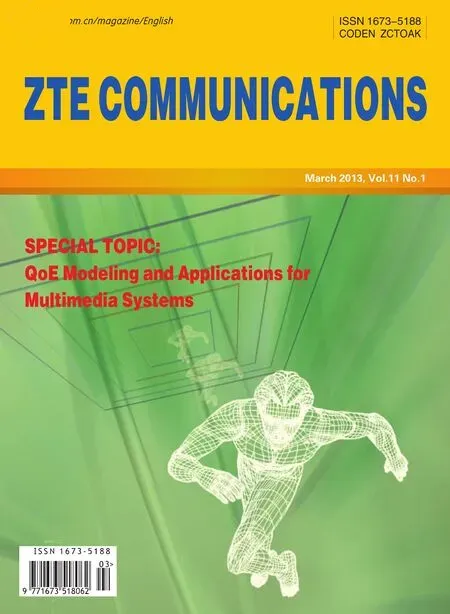QoE Modeling and Applicationsfor Multimedia Systems
▶Wenjun Zeng

Wenjun Zeng (zengw@missouri.edu)is a professor and the director of the Mobile Networking and Multimedia Communications Lab in the Computer Science Department,University of Missouri.He received his BE degree from Tsinghua University,his MSdegree from the University of Notre Dame,and his PhD degree from Princeton University.His research interests include mobile computing,social media analysis,semantic search,distributed source/video coding,3-D analysis and coding,multimedia networking,and content and network security.He is the editor of Multimedia Security Technologies for Digital Rights Management
(Elsevier,2006)and hasbeen granted 15 USpatents.
Prior to joining the University of Missouri in 2003,he worked for PacketVideo Corp.,Sharp Labs America,Bell Labs,and Panasonic Technology.He is an associate editor of IEEE Transactions on Information Forensics and Security,IEEE Transactions on Circuits and Systems for Video Technology,and IEEE Multimedia Magazine.He is also on the Steering Committee of IEEE Transactions on Multimedia.Heis afellow of the IEEE.
▶Weisi Lin

Weisi Lin(wslin@ntu.edu.sg)received his PhD from King's College,London.He was the lab head of visual processing at Infocomm Research,Singapore,and also acting manager of the media processing department at the same institute.Currently,he is an associate professor in the School of Computer Engineering,Nanyang Technological University,Singapore.His research interests include imageprocessing,perceptual quality evaluation,video compression,multimedia communication,and computer vision.He has published more than 200 refereed papers in international journals and conferencesproceedings.
He is on the editorial boards of IEEE Transactions on Multimedia,IEEE Signal Processing Letters,and Journal of Visual Communication and Image Representation.In 2012,he was the lead guest editor of a special issue of
IEEE Journal of Selected Topics in Signal Processing on perceptual signal processing.He chairs the IEEE MMTC Special Interest Group on Quality of Experience and is an elected Distinguished Lecturer of APSIPA(2012/3).He holds the PCM 2012 Lead Technical Program Chair and a Technical Program Chair for IEEEICME 2013.He is a fellow of Institute of Engineering Technology and an honorary fellow of the Singapore Institute of Engineering Technologists.
I Improving the quality and experience perceived by the user is fundamental when developing multimedia technologies,products,and services.Quality of experience(QoE)involves subjective perception,user behavior and needs,appropriateness,context,and usability of delivered content.Modeling QoE is critical for enhancing QoE in various multimedia applications.In this special issue,we present the latest developments,trends,challenges,and practices in QoEmodeling and applications for multimedia systems.The seven expert papers in this special issue come from academia and industry.They present some of latest developments in QoE modeling and assessment for emerging scenariossuch as3Dvideo,streamingand cloud systems,user generated content,and mobile user experience.
We start with two papers that address the problems in 3D QoEassessment and perceptually-driven compression.In“Methodologies for Assessing 3D QoE:Standards and Explorative Studies,”Chen et al.describe the fundamentals of existing subjective video quality assessment methods that are the starting point for 3DTV QoE assessment.The authors discuss potential methods for assessing QoEin stereoscopic 3DTV,focusing mainly on multidimensional QoE indicators and common features of subjective assessment.In“3D Perception Algorithms:Towards Perceptually Driven Compression of 3D Video,”Hu et al.highlight the differences in perceptual effects between 2D and 3D video.They then share their ideas about 3Dvideo coding and transmission,taking into consideration 3Dvisual attention,3D just-noticeable-difference,and 3D texture synthesis modeling.We hope that these two papers prompt further thinkingabout emerging3Dsignal processing.
QoE estimation and modeling has been an important tool for improving user experience in multimedia communication systems.In“Estimating Reduced-Reference Video Quality for Quality-Based Streaming Video,”Atzori et al.analyze reduced-reference algorithms for modeling signal distortion,modeling the human visual system,and analyzing the video signal source.The authors then discuss the practical use of these reduced-reference techniques for monitoring and controlling quality in streaming video systems.As the mobile cloud computing paradigm emerges,QoEhas become a much more important issue to investigate.In“Human-Centric Composite-Quality Modeling and Assessment for Virtual Desktop Clouds,”Xu et al.proposeanovel referencearchitectureand discussitsusein modelingand assessingobjective user QoE within virtual desktop clouds.This architecture avoids the need for expensive and time-consuming subjective evaluation.
With the widespread use of smartphones,digital cameras,imaging software,photo-sharing sites,and social networks,the amount of user-generated content has grown tremendously.In“Assessing the Quality of User-Generated Content,”Winkler compares the traditional approaches to assessing quality of user-generated content with new approaches.Some sample applications are also discussed.In“An Improved Color Cast Detection Method Based on Ab-Chromaticity Histogram,”Lu et al.propose a new method for evaluating the quality of an image in order to improve color cast detection.This is a necessary step before further image processing,such aswhitebalance,isapplied.
Energy consumption is a big issue for mobile devices and services.In“Battery Voltage Discharge Rate Prediction and Video Content Adaptation in Mobile Devices on 3G Access Networks,”Mkwawa and Sun propose a way of performing visual content adaptation that saves energy.A regression model is used to predict the battery voltage discharge rate in VoIP applications.This is an interesting attempt.Optimizing user experience with a limited battery is challenging for practical systemdesign(starting from algorithm development).
The guest editorial team would like to thank all authors for submitting their high-quality work to this special issue.We would also like to thank the reviewers whose hard work and expert contributions have ensured the quality of this issue.We hope you enjoy reading these finequality papers.
- ZTE Communications的其它文章
- Methodologiesfor Assessing 3D QoE:Standardsand Explorative Studies
- 3D Perception Algorithms:Towards Perceptually Driven Compression of 3D Video
- New Member of ZTECommunications Editorial Board
- Estimating Reduced-Reference Video Quality for Quality-Based Streaming Video
- Human-Centric Composite-Quality Modeling and Assessment for Virtual Desktop Clouds
- Assessing the Quality of User-Generated Content

